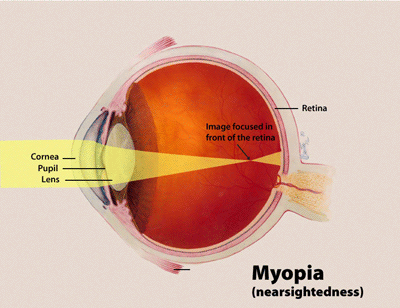
Eye Health and Treatments
Our eyes are like complex cameras that gather, focus, and receive light through the lens to form an image of our surroundings. Without healthy eyes, many of our day to day activities can be hindered or even unattainable. Other than regular eye exams, what else can we do to prevent, maintain and help heal our eyes?
At ANHC we take thousands of years of Traditional Chinese Medicine experience and refine it to help with alleviating modern day eye disorders. Some of the most common and severe eye diseases that we see frequently are listed below:

Myopia (Nearsightedness)

Like all of our tissues and organs, the eyes can be overworked and overburdened, especially with our demanding modern day lifestyles. Our children in particular are now spending more time than previous centuries with their eyes glued on electronic devices either studying on or for entertainment.
To help them avoid a progressive decline in their vision or even surgery in the future, ANHC has created a series of acupressure exercises to help alleviate and even recover their visions. Because children can be scared of needles, the acupuncture treatment is optional although it is recommended. Herbal formulas can be used to help speed up the healing process as well.
Macular Degeneration

Cover one eye and stare at the center dot in this grid. Seeing blurry, curvy, or distorted lines or empty spots could be a sign of macular degeneration. Repeat, covering the other eye.

This grid shows how the lines might look to someone with macular degeneration.

Macular degeneration impairs central vision, and typically does not affect the eye’s side, or peripheral vision. Those with AMD may have difficulty with daily tasks that require fine vision such as reading, driving, and recognizing faces.

Age-related Macular Degeneration (AMD) is a disease most commonly affecting people over the age of 60, and is the leading cause of blindness in geriatrics. AMD is caused by degeneration of the blood vessels in the choroid, the thin layer of blood vessels that supplies oxygen and nutrients to the photoreceptors in the macula and retina. To do this, the blood vessels must connect through the retinal pigment epithelium. The RPE is responsible for recycling waste from photoreceptors and portions the retina through the choroid. In macular degeneration, the RPE is stressed causing waste to collect and forming yellow spots known as drusen. When the waste material forms enough drusen, a larger soft drusen may start to form under the RPE which leads to a high risk of developing AMD. A diagnosis of AMD is made after observing several soft drusen formations. If left unnoticed, a pigment epithelial detachment (PED) may occur. The obstruction due to the drusen or blood vessels obstrustion are the main cause of PED and vision loss.
Cataracts

A cataract is a painless clouding of the eye's lens. A healthy lens is made of mainly water and proteins, and remains clear and is able to focus light into the retina. As we age, some of the protein may clump together and form larger clouds which can impair normal vision. Most cases occur in older people, but sometimes they can be seen in younger people as well. Over half of Americans over 65 have cataracts. Symptoms include glares, or sensitivity to light, and double vision occurring independently in each eye. Colors may appear faded, and the overall vision has a yellowish or brownish hue. If left untreated, it can lead to blindness.
Along with Acpunture and herbal formulas, ANHC has helped many patients regain clear vision again.
Floaters



